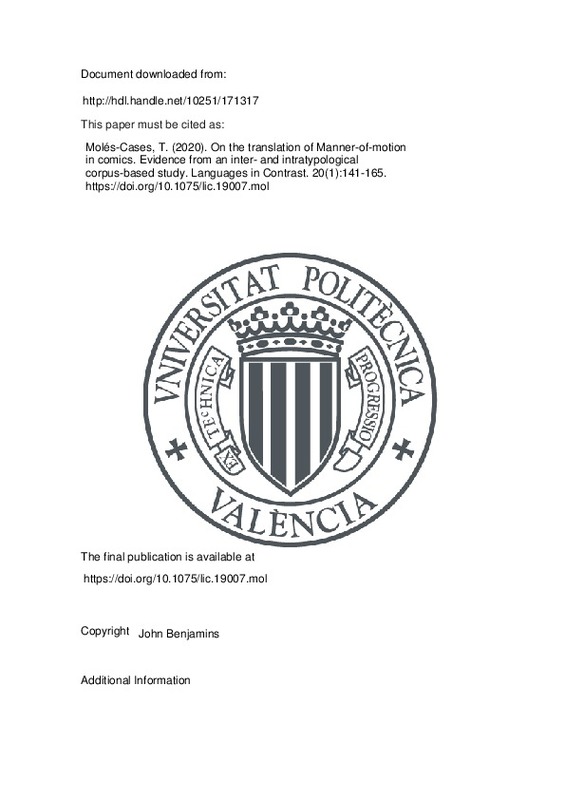Akita, K. and Y. Matsumoto. 2012. Manner Salience Revisited: Evidence from two Japanese-English Contrastive Experiments. Unpublished manuscript.
Alonso, R. A. (2017). Translating motion events into typologically distinct languages. Perspectives, 26(3), 357-376. doi:10.1080/0907676x.2017.1387578
Cappelle, B. (2012). English is less rich in manner-of-motion verbs when translated from French. Across Languages and Cultures, 13(2), 173-195. doi:10.1556/acr.13.2012.2.3
[+]
Akita, K. and Y. Matsumoto. 2012. Manner Salience Revisited: Evidence from two Japanese-English Contrastive Experiments. Unpublished manuscript.
Alonso, R. A. (2017). Translating motion events into typologically distinct languages. Perspectives, 26(3), 357-376. doi:10.1080/0907676x.2017.1387578
Cappelle, B. (2012). English is less rich in manner-of-motion verbs when translated from French. Across Languages and Cultures, 13(2), 173-195. doi:10.1556/acr.13.2012.2.3
Cohn, N. (2014). Building a better ‘comic theory’: Shortcomings of theoretical research on comics and how to overcome them. Studies in Comics, 5(1), 57-75. doi:10.1386/stic.5.1.57_1
Edwards, M. (2001). Making the implicit explicit for successful communication: pragmatic differences between English and Spanish observable in the translation of verbs of movement. Revista Alicantina de Estudios Ingleses, (14), 21. doi:10.14198/raei.2001.14.02
Filipović, L. (2008). Typology in action: applying typological insights in the study of translation. International Journal of Applied Linguistics, 18(1), 23-40. doi:10.1111/j.1473-4192.2008.00189.x
25. Motion. (2015). Handbook of Cognitive Linguistics, 527-546. doi:10.1515/9783110292022-026
Forceville, C. (2011). Pictorial runes in Tintin and the Picaros. Journal of Pragmatics, 43(3), 875-890. doi:10.1016/j.pragma.2010.07.014
Ibarretxe-Antuñano, I., & Filipović, L. (s. f.). Lexicalisation patterns and translation. Cognitive Linguistics and Translation. doi:10.1515/9783110302943.251
Kopecka, A. (2010). Chapter 9. Motion events in Polish. New Approaches to Slavic Verbs of Motion, 225-246. doi:10.1075/slcs.115.14kop
Molés-Cases, T. (2016). La traducción de los eventos de movimiento en un corpus paralelo alemán-español de literatura infantil y juvenil. doi:10.3726/978-3-653-06745-3
Molina, L., & Hurtado Albir, A. (2004). Translation Techniques Revisited: A Dynamic and Functionalist Approach. Meta, 47(4), 498-512. doi:10.7202/008033ar
Rojo, A., & Ibarretxe-Antuñano, I. (Eds.). (2013). Cognitive Linguistics and Translation. doi:10.1515/9783110302943
Slobin, D. I. (1991). Learning to think for speaking. Pragmatics, 1(1), 7-25. doi:10.1075/prag.1.1.01slo
Slobin, D. I. (1997). Mind, Code and Text. Essays on Language Function and Language Type, 437. doi:10.1075/z.82.24slo
Slobin, D. I. (2000). Verbalized events. Current Issues in Linguistic Theory, 107. doi:10.1075/cilt.198.10slo
Slobin, D. I. (s. f.). Relating Narrative Events in Translation. Perspectives on Language and Language Development, 115-129. doi:10.1007/1-4020-7911-7_10
Toratani, K. (2012). The role of sound-symbolic forms in Motion event descriptions. Review of Cognitive Linguistics, 10(1), 90-132. doi:10.1075/rcl.10.1.03tor
Tversky, B., & Chow, T. (2017). Language and Culture in Visual Narratives. Cognitive Semiotics, 10(2). doi:10.1515/cogsem-2017-0008
[-]







![[Cerrado]](/themes/UPV/images/candado.png)


